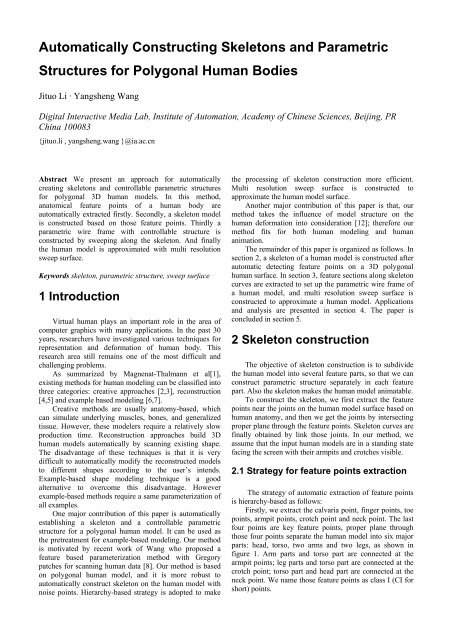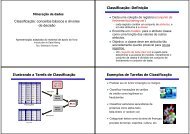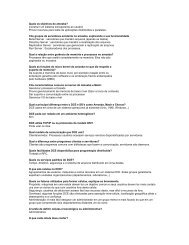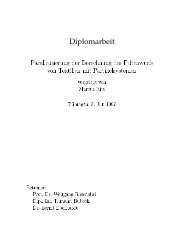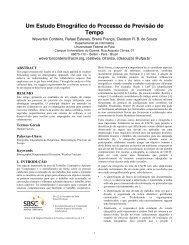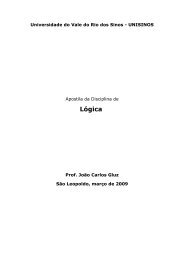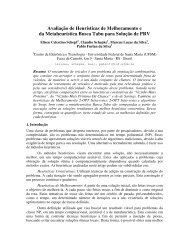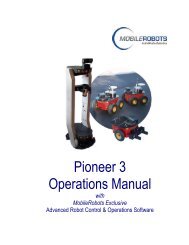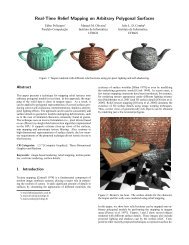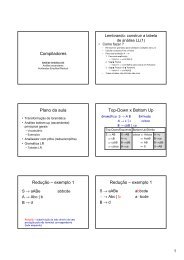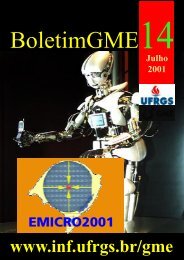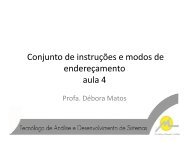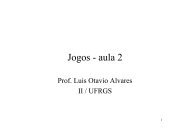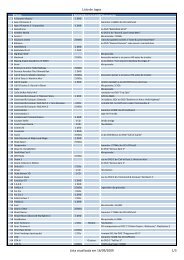Automatically Constructing Skeletons and Parametric Structures for ...
Automatically Constructing Skeletons and Parametric Structures for ...
Automatically Constructing Skeletons and Parametric Structures for ...
You also want an ePaper? Increase the reach of your titles
YUMPU automatically turns print PDFs into web optimized ePapers that Google loves.
<strong>Automatically</strong> <strong>Constructing</strong> <strong>Skeletons</strong> <strong>and</strong> <strong>Parametric</strong><br />
<strong>Structures</strong> <strong>for</strong> Polygonal Human Bodies<br />
Jituo Li · Yangsheng Wang<br />
Digital Interactive Media Lab, Institute of Automation, Academy of Chinese Sciences, Beijing, PR<br />
China 100083<br />
{jituo.li , yangsheng.wang }@ia.ac.cn<br />
Abstract We present an approach <strong>for</strong> automatically<br />
creating skeletons <strong>and</strong> controllable parametric structures<br />
<strong>for</strong> polygonal 3D human models. In this method,<br />
anatomical feature points of a human body are<br />
automatically extracted firstly. Secondly, a skeleton model<br />
is constructed based on those feature points. Thirdly a<br />
parametric wire frame with controllable structure is<br />
constructed by sweeping along the skeleton. And finally<br />
the human model is approximated with multi resolution<br />
sweep surface.<br />
Keywords skeleton, parametric structure, sweep surface<br />
1 Introduction<br />
Virtual human plays an important role in the area of<br />
computer graphics with many applications. In the past 30<br />
years, researchers have investigated various techniques <strong>for</strong><br />
representation <strong>and</strong> de<strong>for</strong>mation of human body. This<br />
research area still remains one of the most difficult <strong>and</strong><br />
challenging problems.<br />
As summarized by Magnenat-Thalmann et al[1],<br />
existing methods <strong>for</strong> human modeling can be classified into<br />
three categories: creative approaches [2,3], reconstruction<br />
[4,5] <strong>and</strong> example based modeling [6,7].<br />
Creative methods are usually anatomy-based, which<br />
can simulate underlying muscles, bones, <strong>and</strong> generalized<br />
tissue. However, these modelers require a relatively slow<br />
production time. Reconstruction approaches build 3D<br />
human models automatically by scanning existing shape.<br />
The disadvantage of these techniques is that it is very<br />
difficult to automatically modify the reconstructed models<br />
to different shapes according to the user’s intends.<br />
Example-based shape modeling technique is a good<br />
alternative to overcome this disadvantage. However<br />
example-based methods require a same parameterization of<br />
all examples.<br />
One major contribution of this paper is automatically<br />
establishing a skeleton <strong>and</strong> a controllable parametric<br />
structure <strong>for</strong> a polygonal human model. It can be used as<br />
the pretreatment <strong>for</strong> example-based modeling. Our method<br />
is motivated by recent work of Wang who proposed a<br />
feature based parameterization method with Gregory<br />
patches <strong>for</strong> scanning human data [8]. Our method is based<br />
on polygonal human model, <strong>and</strong> it is more robust to<br />
automatically construct skeleton on the human model with<br />
noise points. Hierarchy-based strategy is adopted to make<br />
the processing of skeleton construction more efficient.<br />
Multi resolution sweep surface is constructed to<br />
approximate the human model surface.<br />
Another major contribution of this paper is that, our<br />
method takes the influence of model structure on the<br />
human de<strong>for</strong>mation into consideration [12]; there<strong>for</strong>e our<br />
method fits <strong>for</strong> both human modeling <strong>and</strong> human<br />
animation.<br />
The remainder of this paper is organized as follows. In<br />
section 2, a skeleton of a human model is constructed after<br />
automatic detecting feature points on a 3D polygonal<br />
human surface. In section 3, feature sections along skeleton<br />
curves are extracted to set up the parametric wire frame of<br />
a human model, <strong>and</strong> multi resolution sweep surface is<br />
constructed to approximate a human model. Applications<br />
<strong>and</strong> analysis are presented in section 4. The paper is<br />
concluded in section 5.<br />
2 Skeleton construction<br />
The objective of skeleton construction is to subdivide<br />
the human model into several feature parts, so that we can<br />
construct parametric structure separately in each feature<br />
part. Also the skeleton makes the human model animatable.<br />
To construct the skeleton, we first extract the feature<br />
points near the joints on the human model surface based on<br />
human anatomy, <strong>and</strong> then we get the joints by intersecting<br />
proper plane through the feature points. Skeleton curves are<br />
finally obtained by link those joints. In our method, we<br />
assume that the input human models are in a st<strong>and</strong>ing state<br />
facing the screen with their armpits <strong>and</strong> crotches visible.<br />
2.1 Strategy <strong>for</strong> feature points extraction<br />
The strategy of automatic extraction of feature points<br />
is hierarchy-based as follows:<br />
Firstly, we extract the calvaria point, finger points, toe<br />
points, armpit points, crotch point <strong>and</strong> neck point. The last<br />
four points are key feature points, proper plane through<br />
those four points separate the human model into six major<br />
parts: head, torso, two arms <strong>and</strong> two legs, as shown in<br />
figure 1. Arm parts <strong>and</strong> torso part are connected at the<br />
armpit points; leg parts <strong>and</strong> torso part are connected at the<br />
crotch point; torso part <strong>and</strong> head part are connected at the<br />
neck point. We name those feature points as class I (CI <strong>for</strong><br />
short) points.
Secondly, in each major part, we extract the points<br />
with anthropometric semantic, including chest point, waist<br />
point, elbow points, wrist points, thigh points, knee points<br />
<strong>and</strong> ankle points. Proper plane through those feature points<br />
can further subdivide the human model into several subregions,<br />
as shown in figure 2. We call those feature points<br />
as class II(CII <strong>for</strong> short) points. The CI <strong>and</strong> CII feature<br />
points determine the skeleton of a human model, which<br />
will be detailed late.<br />
Feature points of class III(CIII <strong>for</strong> short) are located in<br />
sub-regions, as shown in figure 3, including under-breast<br />
point, pelvis point, middle upper arm points <strong>and</strong> so on,<br />
those feature points indicate the major surface change in<br />
their corresponding regions.<br />
Fig. 1 Class I feature points<br />
Fig. 2 Class II feature points<br />
Fig. 3 Class III feature points<br />
2.2 Detailed method <strong>for</strong> feature points<br />
extraction<br />
During the extraction of feature points, the calvaria<br />
point, two finger points <strong>and</strong> two toe points are extracted by<br />
detecting the vertices with minimal or maximal coordinate.<br />
For instance, the left finger has the minimal value along Y<br />
axis in neighboring region of the vertex with the maximal<br />
value in X axis. The most difficult <strong>and</strong> most important<br />
feature points to be extracted are the armpit points <strong>and</strong><br />
crotch point. To automatically extract them, we use some<br />
planes to intersect the human model, as shown in figure 1,<br />
<strong>and</strong> the feature points are near the turning points on the 2D<br />
contours.<br />
For the armpit points, we intersect the human model<br />
with horizontal planes from its 3/4 height upside literately.<br />
Once the intersecting section breaks into two loops, we<br />
stop the iteration. And assume the armpit points locate in<br />
the previous intersecting section, near the left <strong>and</strong> right<br />
turning points of the intersecting section. To extract the<br />
turning point, Wang [8] used an angle-based method, i.e. if<br />
an angle <strong>for</strong>med by three adjacent points is smaller than a<br />
threshold, then it is a turning point. It is the case with the<br />
premises that there are no noise points on the human<br />
model. However, in most scanning models, noise points<br />
exist, as shown in the section near armpits in figure 1. If we<br />
directly use Wang’s method, error may occur. Here, we<br />
proposed an alternative way to robustly extract feature<br />
points. We firstly scan the intersecting section with rays<br />
parallel to Z axis to get pairs of sampling points. Then, we<br />
compute the distance of each pair. We chose the two pairs<br />
with minimal distance on the right <strong>and</strong> left side of the<br />
center of the intersecting section. And set the middle point<br />
of each pair as the left or right armpit point. As shown in<br />
figure 4, with this method, we can robustly extract the<br />
armpit points, as shown in red point in figure 4. And we<br />
use this method to extract the crotch point similarly.<br />
When the armpit points are extracted, we intersect the<br />
human model with two planes containing the armpit points<br />
respectively with their normal parallel to X axis to get the<br />
shoulder points. The shoulder points are those points with<br />
maximal value in Y axis on the intersecting section, as<br />
shown in figure 5.<br />
The neck point is extracted by cutting the human<br />
model with a plane parallel to XOZ plane above the<br />
shoulder points iteratively. The neck point is ideally on the<br />
section with minimal contour in the region of neck.<br />
However, in our experiments, we find that this criterion<br />
may fall to work because of surface noise. Indeed, we stop<br />
the cutting iteration when the difference of perimeter<br />
between the current section <strong>and</strong> previous section is smaller<br />
than a threshold. The neck point locates on the central front<br />
point of current intersecting section, as shown in figure 5.<br />
Planes passing through armpit points with their<br />
normal parallel to X axis <strong>and</strong> planes passing through neck<br />
point <strong>and</strong> crotch point respectively with their normal<br />
parallel to Y axis divide the human model into six major<br />
parts as shown in different color in figure 1.<br />
(a) Section near armpits (b) Scanning in Z direction<br />
Fig.4 Extract armpit points<br />
Fig.5 Extract neck point
When CI feature points are extracted, an initial<br />
skeleton is established with the head point, armpit points,<br />
finger points, crotch points <strong>and</strong> toe points, as shown in<br />
figure 6(a). Based on anthropometry [13], CII feature<br />
points are detected on the intersecting sections<br />
perpendicular to the initial skeleton. For example, waist<br />
point locates on the section with maximal Z value on its<br />
back part among the sections between armpit points <strong>and</strong><br />
crotch points. The back part of a section can be extracted<br />
by computing the dot product between the view direction<br />
(initially, (0,0,1)) <strong>and</strong> normal on points of the section. If<br />
dot product on a vertex is smaller than zero, then the vertex<br />
is on the back part of the section.<br />
CIII feature points are extracted with the similar<br />
method as <strong>for</strong> CII feature points. Take pelvis points as an<br />
instance, pelvis locates on the section with minimal Z value<br />
on its back part among the sections between waist point<br />
<strong>and</strong> crotch point.<br />
In our methods, CII feature points are extracted in<br />
corresponding separated body parts instead of the whole<br />
human model, there<strong>for</strong>e computation is reduced. Proper<br />
planes passing through the CII feature points further<br />
subdivide the human model into smaller regions as shown<br />
in figure 2, <strong>and</strong> CIII feature points are efficiently extracted<br />
in those smaller regions.<br />
2.3 Skeleton<br />
A skeleton is constructed with bones, as shown in<br />
figure 6. Two adjacent bones are linked on a joint. In the<br />
figure, joints are displayed in green spheres. A skeleton is<br />
constructed simultaneously during the extraction of feature<br />
points. We set the center of an intersecting section that<br />
corresponds to a feature point as a joint.<br />
(a) initial model (b) final model<br />
Fig.6 Skeleton<br />
3 <strong>Parametric</strong> structure<br />
Feature based parametric structures are fundamental<br />
<strong>for</strong> developing customized human models. Recent work of<br />
Yoon <strong>and</strong> Kim[9] show that, seep-based surface has many<br />
merits in shape de<strong>for</strong>mation <strong>and</strong> animation of arbitrary 3D<br />
objects. Motivated by their work, in this section, we<br />
construct the feature based parametric structure in two<br />
steps. Firstly, a sweep-based wire frame with controllable<br />
structure of a human model is constructed, <strong>and</strong> then the<br />
human model is approximated with multi resolution sweep<br />
surface based on the wire frame.<br />
3.1 Wire frame<br />
Generally, human animation or de<strong>for</strong>mation methods<br />
require a human model segment into head, torso, arms <strong>and</strong><br />
legs. There<strong>for</strong>e, we construct wire frame of each part<br />
separately, <strong>and</strong> then join them together with constrains. The<br />
detailed method is as follows.<br />
Firstly, key sections are extracted along the skeleton<br />
by intersecting some proper planes against a human model<br />
on the feature points, the normal of planes are<br />
perpendicular to the skeleton, as shown in figure 7. The key<br />
sections represent the boundaries <strong>and</strong> the major surface<br />
change of each part of a human model.<br />
Secondly, we interpolate more sections between two<br />
neighboring key sections along the skeleton to make the<br />
human model more controllable, as shown in figure 7(b).<br />
Those sections are called as assistant sections. In a same<br />
region bounded by two key sections, we distribute the<br />
assistant sections evenly. The normal of planes containing<br />
the assistant sections are interpolated between two<br />
neighboring key sections. When we obtain sections in each<br />
human part, the whole sections of a human model is<br />
constructed, as shown in figure 7(c).<br />
Finally, we add constrains of displacement <strong>and</strong><br />
orientation on sections between two boundary sections Ss<br />
<strong>and</strong> Se to construct the wire frame. Suppose Pi <strong>and</strong> Pi+1 are<br />
planes containing two adjacent sections Si <strong>and</strong> Si+1 between<br />
Ss <strong>and</strong> Se respectively, <strong>and</strong> then we have<br />
Pi+1=R(t) Pi + d(t) (1)<br />
where 0≤ t ≤1, R(t) is a 3×3 rotating matrix <strong>and</strong> d(t) is 3×1<br />
translating vector, || d(0)||=0 <strong>and</strong> || d(1)||=||CsCe||, Cs, Ce are<br />
the center of Ss <strong>and</strong> Se. Under equation (1), when we<br />
de<strong>for</strong>m one section on the wire fame, it is conveniently to<br />
update the other sections, which makes human de<strong>for</strong>mation<br />
or animation easy <strong>and</strong> efficient.<br />
(a) key sections<br />
(b) sections in each body part (c) wire frame<br />
Fig. 7 Wire frame of a human mode
3.2 Multi resolution sweep surface<br />
The shape of each human part is cylinder-like, so it is<br />
straight<strong>for</strong>ward to adopt the method <strong>for</strong> creating surfaces<br />
with contours. Our approach <strong>for</strong> mesh generation has two<br />
steps: (1) extract vertices <strong>for</strong> contour curve on sections, <strong>and</strong><br />
(2) surface construction from contours.<br />
To sample vertices on a contour, Wang[8] proposed<br />
an angle-based method. In their method, angels on the<br />
contour center with other two end points as two adjacent<br />
sample vertices on the contour are equal. In this case,<br />
undersampleing problem may easy happen on the curves<br />
with high curvature. Other methods sample vertices using<br />
the curvature criteria, though they can approximate the<br />
surface shape well, the triangulation results with those<br />
vertices usually fall into low quality, which makes against<br />
human de<strong>for</strong>mation or animation.<br />
To create high quality of triangles, we extract the<br />
vertices <strong>for</strong> contour curve as follows. Firstly, according to<br />
the symmetry of human surface, we decompose a section<br />
into four parts by two orthogonal lines with their<br />
intersection fixed on the center of the section, as shown in<br />
figure 8. Secondly, each part is further decomposed into<br />
several sub-parts equidistantly. Then we get the vertices on<br />
the section as shown in colored points in figure 8.<br />
(a) 8 vertices (b) 16 vertices (c) 28 vertices<br />
Fig.8 Section decomposition with multi resolution<br />
The directions of the two orthogonal lines determine<br />
the arrangement of the vertices. To be convenient, we<br />
compute the direction of one line first, we call this line as<br />
principal axis, <strong>and</strong> then the direction of another line can be<br />
easily computed on the plane. The computation of direction<br />
of principal axis Dp takes the silhouette of a human model<br />
into consideration, <strong>and</strong> is computed as follows.<br />
Dp = N× Az (2)<br />
where N is the normal of section, <strong>and</strong> Az (0,0,1)is the<br />
direction of Z axis which parallels to the initial view<br />
direction, “×” means cross product. As a result, when we<br />
link all of the intersections between principal axis <strong>and</strong><br />
sections of a human model, we can get the silhouette of the<br />
human model in front view, as shown in figure 9.<br />
Fig.9 Intersections between principal axis <strong>and</strong> sections<br />
make the silhouette of a human model in front view<br />
Our method can get evenly disturbed vertices on<br />
sections, as shown in figure 8, taking the section of chest<br />
<strong>for</strong> instance. Compared to angle-based method <strong>for</strong><br />
decomposing a section proposed by Wang [8], our method<br />
synthesizes both the advantage of angle-based method <strong>and</strong><br />
length-based method, as a result, the problem of<br />
undersampling on the parts with high curvature is reduced,<br />
<strong>and</strong> the shape quality of triangles <strong>for</strong>med with those<br />
vertices is high, as show in figure 13 <strong>and</strong> 15.<br />
When we control the interval between two<br />
neighboring vertices on a section, we can get multi<br />
resolution vertices on the section, which makes it easy to<br />
construct multi resolution mesh <strong>for</strong> a human model surface.<br />
After obtaining the vertices on contour curves, we can<br />
easily construct the surface of each part of human body<br />
with Meyers’s method [10]. One technical challenge is how<br />
to combine the neighboring parts around the shoulder <strong>and</strong><br />
the hip, where surfaces with different shape meet. We<br />
address this by creating a transition surface between two<br />
neighboring surfaces, as shown in figure 10. Our approach<br />
of creating transition surface can be divided into two steps:<br />
initial construction <strong>and</strong> optimization.<br />
In constructing the transition surface linking arm,<br />
shoulder <strong>and</strong> torso parts, firstly we sew the surface of<br />
shoulder <strong>and</strong> torso by linking the vertices on the bottom<br />
boundary of shoulder surface <strong>and</strong> their nearest counterparts<br />
on the top boundary of the torso surface. As shown in<br />
figure 11(b), when we triangulation the vertices on chest<br />
section <strong>and</strong> the end points of shoulder sections, a triangle<br />
strip can be get, as shown in figure 10(b), <strong>and</strong> a closed loop<br />
containing the side boundary of a shoulder <strong>and</strong> part of chest<br />
section can also be gotten, as shown in figure 11(c).<br />
Secondly, we use this newly created closed loop Ln <strong>and</strong> the<br />
armhole section Sa to create a surface as follows:<br />
(1) Initialize the angle of each vertex on Ln <strong>and</strong> Sa by<br />
using polar coordinate, with the origin of the polar axis as<br />
the center of Ln <strong>and</strong> Sa respectively. The direction of polar<br />
axis is defined by equation(2), as shown in figure 11(c).<br />
Here the normal of Ln is defined as the normal on average<br />
plane of Ln.<br />
(2) To a vertex vi with polar angle αi on Sa, we find a<br />
vertex vj with polar angle βj on Ln which has the minimal |αi<br />
-βj | to make a edge, as shown in figure 11(c). With this<br />
rule, we can initially create a transition surface as shown in<br />
figure 10.<br />
(3) The initial transition surface is further smoothed<br />
with edge exchange [11] as shown in figure 10.<br />
In above method, all of vertices on the transition<br />
surface are shared with the arm, shoulder <strong>and</strong> torso parts,<br />
thus the transition surface stitch the three separated parts<br />
into one surface.<br />
We use the similar method to create the transition<br />
surface linking torso <strong>and</strong> thighs. The major difference is<br />
that we insert an additional vertex between the two turning<br />
points on the crotch section to break the section into two<br />
closed loops, as shown in figure 12. With this pretreatment,<br />
the construction of transition surface between the torso <strong>and</strong><br />
thighs becomes straight<strong>for</strong>ward. The result is shown in<br />
figure 10. With the transition surfaces, the six separated<br />
body parts are combined into one surface, as shown in<br />
figure 13.
(a) Sweep surface in each part (b) Transition surface<br />
Fig.10 Sweep surface of a human model<br />
(a) initial sections (b) create shoulder boundary loop<br />
(c) sew arm hole <strong>and</strong> shoulder boundary loop together<br />
Fig. 11 Sections treatment in constructing transition surface<br />
combing torso, arm <strong>and</strong> shoulder<br />
(a) initial crotch section (b) after disposure<br />
Fig. 12 Crotch section treatment in constructing transition<br />
surface combing torso <strong>and</strong> thighs<br />
4 Applications <strong>and</strong> analysis<br />
According to the recent work of Yoon <strong>and</strong> Kim[9] <strong>and</strong><br />
Hyun et al.[12], sweep-based surface has many merits in<br />
free <strong>for</strong>m de<strong>for</strong>mation than general polygonal mesh<br />
surface. In their methods, the most difficult <strong>and</strong> time<br />
consuming step in sweep-based surface de<strong>for</strong>mation is to<br />
construct control sweep surfaces <strong>for</strong> de<strong>for</strong>mable parts of an<br />
object [9]. In this paper, take 3D polygonal human model<br />
as input data, we present a natural <strong>and</strong> efficient way to<br />
automatically create multi resolution sweep-based surfaces<br />
<strong>for</strong> human models. For instance, to reconstruct a high<br />
resolution sweep surface on a man model with 23888<br />
triangles, as shown in figure 13, the computational time is<br />
less than 1.5s on a PIV 1.5G Hz PC with 512M main<br />
memory. And the computational time of reconstructing the<br />
sweep surface of a female model with 60860 triangles is<br />
about 2s.<br />
In our methods, the number of vertices on a section<br />
can be freely controlled, which makes it easy to create<br />
body structures with different shape quality, as shown in<br />
figure 13. And since the body structure is independent with<br />
the shape of human models, every human model<br />
reconstructed in this way is parameterized, which makes it<br />
easy to morph from one model to another, as shown in<br />
figure 14.<br />
The reconstructed body surface can conveniently <strong>and</strong><br />
efficiently de<strong>for</strong>med by editing the shape of sections on its<br />
parametric structure. And de<strong>for</strong>mation region is easy to be<br />
controlled with constrains between sections provided by<br />
equation (1). As shown in figure 15, when we edit the waist<br />
section, the de<strong>for</strong>mation of its neighboring sections<br />
between the chest section <strong>and</strong> the crotch section can be<br />
smoothly interpolated, since to each vertex on the waist<br />
section, its counterparts on the neighboring sections can be<br />
easily found in the parametric structure.<br />
Furthermore, our methods can be used as the<br />
pretreatment of example-based human modeling, as those<br />
methods usually require a same parameterization of all<br />
examples [7].<br />
Our methods can automatically construct the skeleton<br />
of a human model, which is very useful <strong>for</strong> generating<br />
articulated models without the interaction of the user,<br />
especially in animating scanned human models. In our<br />
methods, human surface vertices are located on sections<br />
which are obtained by intersecting planes along human<br />
skeleton, there<strong>for</strong>e the vertices can naturally combined onto<br />
the skeleton with the method proposed by Shen et al [14],<br />
which makes human de<strong>for</strong>mation or animation efficient.<br />
Based on the above applications <strong>and</strong> analysis, we can<br />
see that our methods has many merits both in human<br />
modeling <strong>and</strong> human de<strong>for</strong>mation.<br />
5 Conclusion<br />
In this paper, we present a natural <strong>and</strong> efficient<br />
approach <strong>for</strong> creating parametric structures of human<br />
models. Feature-based technique is adopted to<br />
automatically construct the skeleton of a polygon human<br />
model. Then the entire human model is subdivided into<br />
several parts. Multi resolution sweep surface with<br />
controllable wire frame structure are created separately in<br />
each part, <strong>and</strong> neighboring parts are combined with smooth<br />
transition surfaces. Our methods can automatically obtain<br />
the skeleton <strong>and</strong> parametric sweep structure of a human<br />
model, which makes following human animation <strong>and</strong><br />
de<strong>for</strong>mation very convenient.<br />
Acknowledgements The authors would like to thank<br />
anonymous reviewers <strong>for</strong> their invaluable comments.<br />
References<br />
1. Magnenat-Thalmann N. , Seo H. , Cordier F.,<br />
Automatic modeling of animatable virtual humans - a<br />
survey.In: 3-D Digital Imaging <strong>and</strong> Modeling (3DIM),<br />
Banff, Canada 2003. 2-11<br />
2. Shen J., D. Thalmann. Interactive shape using meatballs<br />
<strong>and</strong> splines. In Association, M-P. Gascuel <strong>and</strong> B.<br />
Wyvill, eds. Proc. of Implicit Surface’95, Grenoble,<br />
France, 1995. 187-196<br />
3. Scheeepers F., R.E.Parent, W.E. Carlson, et al.<br />
Anatomy-based modeling of the human musculature. In:
Turner Whitted, ed., Proc. SIGGRAPH'97, Los Angeles,<br />
CA, USA, 1997, pp.163-172. Addison Wesley(1997)<br />
4. Wang C.C.L., Cheng T.K.K., <strong>and</strong> Yuen M.M.F., From<br />
laser-scanned data to feature human model: a system<br />
based on fuzzy logic concept. CAD, 35(3), 241-<br />
253( 2003).<br />
5. Cordier F., Magnenat-Thalmann. N. Realtime animation<br />
of dressed virtual humans. Comp. Graph. Forum 21(3),<br />
327-336 (2002)<br />
6. Sloan P.P.J., Rose C.F., <strong>and</strong> Cohen M.F., Shape by<br />
example, In: John H, ed. Proc. 2001 symp. on Interactive<br />
3D graphics, New York, NY, USA , 2001, 135-143.<br />
ACM Press (2001)<br />
7. Seo H., <strong>and</strong> Magnenat-Thalmann N., An Example-Based<br />
Approach to Human Body Manipulation. Graphical<br />
Models 66(1), 1-23(2004)<br />
8. Wang C.C.L. Parameterization <strong>and</strong> <strong>Parametric</strong> Design of<br />
Mannequins. CAD, 37,83-98 (2005)<br />
9.Yoon S.H, Kim M.S. Sweep-based free<strong>for</strong>m<br />
de<strong>for</strong>mations. Comp. Graph. Forum, 25(3),487-<br />
496(2006)<br />
10. Meyers D., S. Skinner, K. Sloan. Surface from<br />
contours. ACM Trans Graph 11(3), 228-258 (1992)<br />
11.Hoop H., DeRose T., Duchamp T., et al. Mesh<br />
optimization. In: James T. Kajiya, eds. SIGGRAPH 93.<br />
Orl<strong>and</strong>o, 1993.19~26.ACM Press(1993)<br />
12. Hyun D.E., Yoon S. H. Chang J.W. et al. Sweep-based<br />
human de<strong>for</strong>mation. The Vis. Comp. 21(8),542-<br />
550(2005)<br />
13. Ronald E., Kroemer K.H.E, Charffin Donald B.<br />
Anthropometry <strong>and</strong> Biomechanics: Theory <strong>and</strong><br />
Application. New York: Plenum Press, 1982.<br />
14. Shen J., Magnenat Thalmann N., Thalmann D. Human<br />
skin de<strong>for</strong>mation from cross-sections. In: CGI,<br />
Melbourne, 1994, 612~619(1994)<br />
(a) input model (b) low resolution sweep surface (c) middle resolution sweep surface (d) high resolution sweep surface<br />
Fig13. Control sample interval to get difference shape quality of sweep surface<br />
(a) from a child/man to a man/child<br />
(b) from a child/woman to a woman/child<br />
Fig.14 Morph between different human bodies<br />
Fig15. Section-based surface de<strong>for</strong>mation


